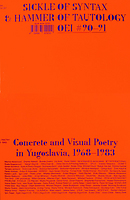
Sickle of Syntax & Hammer of Tautology # 90-91
Concrete and Visual Poetry in Yugoslavia, 1968–1983
Guest edited by
Sezgin Boynik
“’Political’ determinants predominate in the narrative of Yugoslavian concrete poetry, which we present in this issue of OEI. These politics are justified, I would argue, because the inclusion of uneven dynamics enables us to look at the underground, dirty, and distorting aspects of socialist artistic modernism. The reason why some artists and theoreticians are overrepresented compared to others has to do with their politics, which is more aligned with uneven and unpredictable experimental formations than with idealized and purified forms. By giving emphasis to formations rather than forms, and processes instead of structures, my aim here has been to provide a picture of a more vibrant Yugoslavia. The artists and poets of this uneven Yugoslavia were unruly, confrontational, and brave. They were, as Davidson argued, referring to Krishan Kumar, the avant-gardists who thought that ’modern society was not modern enough’.”
INTRODUCTION
PROBLEMS
Sezgin Boynik
This inquiry into concrete an visual poetry production in Yugoslavia begins with 1968 and ends with 1983. The quarter-century of experime al poetry production hardly found its place among early international anthologies dedicated to these types of works, despite the fact that concrete poems were publisheld in the mid-sixties in Ljubljana, and that some of the most established Concrete artists have exhibited regularly since the beginning of the sixties in Zagreb (in the
Nove Tendencije manifestations). Belgrade was also a platform of an internationally active Signalist network. Nothing of this appeared in Emmett Williams', Stephen Bann's, or Mary Ellen Solt's distinctively global anthology of concrete poetry.
Chronologically, this inquiry begins with the OHO group's publication
Katalog–a visual and textual project printed as a special issue of the journal
Problemi in 1968, in Ljubljana. It ends with the visual novel by Vujica Rešin Tucić,
Struganje Mašte [Seraping Imagination], published as a supplement of the journal
Pitanja in 1983, in Zagreb. This periodization is arbitrary as most of the projects were work-in-progress manifestations subscribing to the ethics of experimental poetry based on processual and openended practice. Before it was published as a supplement in 1983, portions of
Struganje were printed in the cultural journals
Ulaznica (1970),
Student (1971), and
Knjizevene Reci (1973); it it was planned to be publised – but this was never realized – in the form of a six metre long kunstdruck paper packed inside a salt box.
Therefore, the story of Yugoslav concrete and visual poetry I want to present here is one that existed in the pages or culture and art journals with high circulations. The emphasis is given to the most democratic and popular forms, or the so-called 'official' representations, of experimental poetry in socialist Yugoslavia. Both
Problemi and
Titania were published in several thousand copies – unimaginable today for any journal publishing experimental form of art—and was run with steady financial support, either directly from state subventions or from Student Unions and Associations.
The methodology I pursued in collecting materials for this issue is similarly democratic: I have mostly used the public libraries of public institutions available for everyone. No private collection has been consulted in this inquiry, except my own, which has been assembled in flea markets and second-hand shops often for prices smaller than those of bestsellers sold in kiosks.
The 'public' methodology influenced the scope of the inquiry: the examples are predominantly canonical works of concrete and visual poetry. The issue opens with the OHO group. One can not get more canonical and official — perhaps maybe with the exception of NSK (
Neue Slowenische Kunst). Marko Pogačnik, a member of the OHO, designed the official coat of arms of the newly independent state of Republic of Slovenia in 1991, the major international fellowship award for young artists in Slovenia is named the OHO Award, all the members and collaborators of the OHO are now either established university professors or public figures.
Publicerad: 2021-03-10
Köp OEI
Läs mer om OEI i katalogen
Fler artiklar knutna till OEI
Fler tidskrifter i kategori LITTERATUR
Fler tidskrifter i kategori KONST & DESIGN
